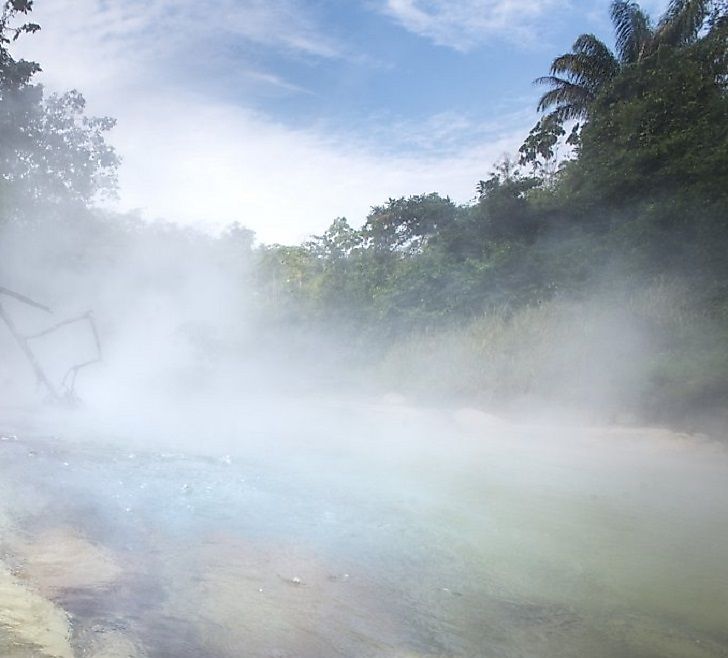Did You Know There Is A Deadly Boiling River In Peru That Dooms All That Fall In It?

5. Where Is The Boiling River?
The mysterious and deadly boiling river, whose ancient name is believed to be Shanay-timpishka (meaning ‘boiled with the heat of the sun’ in a local language), is located deep in the heart of the Amazon rainforests of Peru in South America. The river runs for a distance of nearly 4 miles, and is 80 feet in width at its widest point, and achieves a maximum depth of 16 feet. Though the river was originally believed to be only a part of local legends and folklore without a real presence in the natural world, its existence in the Peruvian forests was recently proven by the Peruvian geoscientist Andrés Ruzo. The most bewildering fact about this river is that it has an average temperature of 86 degrees Celsius, even though it is not located in any volcanic region (the nearest volcanic system is located 700 kilometers away from the river) unlike previously discovered geothermal springs and other hot water bodies. Also, never before has natural, hot, flowing water covering such a vast area been ever discovered.
4. Why Is It So Hot?
At first, the idea of the existence of a boiling river was completely ridiculed by the peers of Ruzo at his university. Even his thesis adviser regarded the idea to be “stupid”. This disbelief in the existence of the river stemmed from the fact that it would take a tremendous amount of heat to boil even a small section of a river, let alone an entire large river as described in local folklore tales. However, unaffected by the critics and guided only by the lure of the legends, Ruzo attempted to explore the treacherous forests of Peru in search of this river. Receiving funding from the National Geographic Young Explorers grant, Ruzo finally managed to locate the wild boiling river of Peru. His research revealed that the river indeed was boiling hot, and fault-fed hot springs on the river bed were the culprits responsible for heating up the Amazonian river to such temperatures. He also claimed the river is initially fed by rain far upstream, possibly near the Andes mountains, and then flows downstream where its waters are heated up by the Earth’s geothermal energy, forming the largest hydrothermal system on the planet.
3. Role in Local Folklore
The boiling river has long been associated with folklore, mysticism, and spirituality for many generations. The locals of the region, comprising of the Santuario Huistin and the Mayantuyacu native Amazonian healing communities, hold the river as a sacred site of theirs, and a connection point for humans with the spiritual and natural worlds. The highly regarded community healers of these native communities are allowed to visit the river to learn about its mystic healing powers, and communicate with the spirits dwelling in the river. Ruzo himself first came to know about this river from his father, who narrated a tale of Spanish conquistadors who, on their way to demolish the Inca Empire, came back from the depths of the Peruvian jungle claiming to have seen a river that boils from below. This account, and a conversation with his aunt who claimed to have actually swum across the river, inspired him to search for the river. Then, guided by his aunt and his determination, he traveled into the forests to find that the river did indeed exist.
2. Threats to Habitat and Biodiversity
The boiling river of Peru is definitely one of the greatest wonders of nature and, being only recently discovered, there is a great deal more to be learned about its habitat and biodiversity. Ruzo has sought the assistance of biologists Spencer Wells and Jonathan Eisen to sequence the genomes of the microorganisms inhabiting the hot waters of this river. Other organisms, however, have horrendous experiences in the river, and many have been observed by Ruzo to meet their gruesome deaths in the river. The animals that he witnessed fall into the river were slowly boiled to death with their eyes first boiling out and then, unable to swim any more, water entered their mouth and lungs, cooking the animals from the inside out. Surprised by the fact that people have swum across the river, he came to know that only when there are heavy rains in the region, and the hot waters of the river become diluted by the cooler rainwater, do people dare to enter the waters of the boiling river.
1. Conservation Efforts
The discovery of the boiling river revealed the fact that even in the 21st Century there are a number of natural terrestrial wonders which have yet to be discovered. The fact that the forests surrounding the boiling river are facing great threats from deforestation makes it necessary that for the Peruvian Government to speed up efforts to save this and other neighboring unique ecosystems. One of the ways to do this can be by declaring the boiling river as a national monument, and by encouraging responsible ecotourism in the region.











